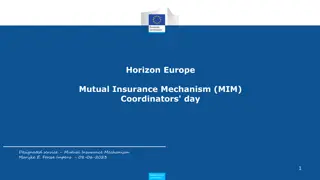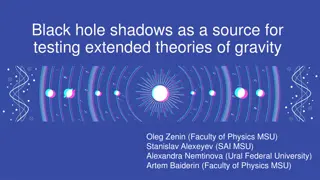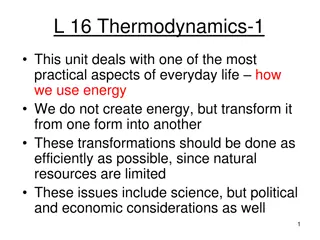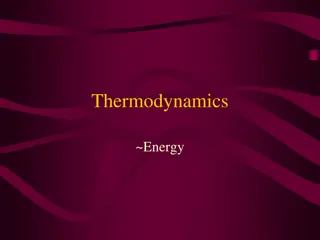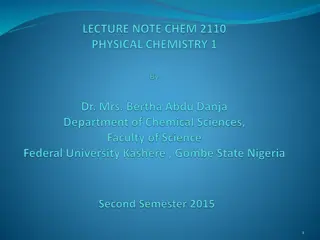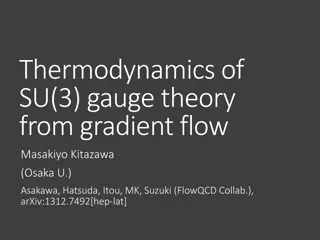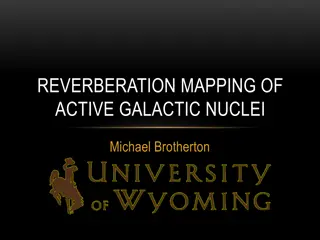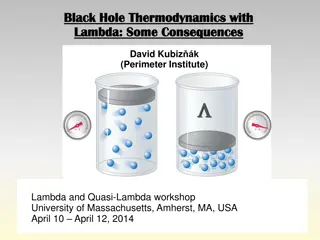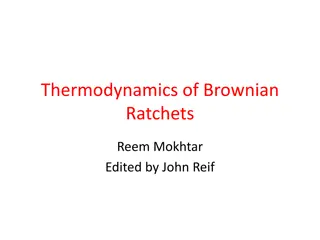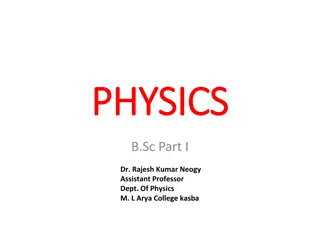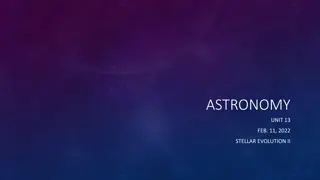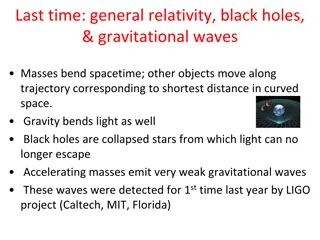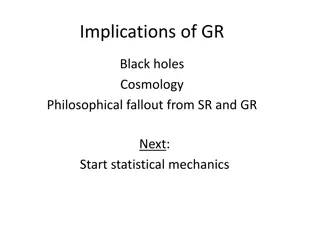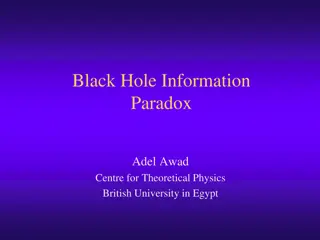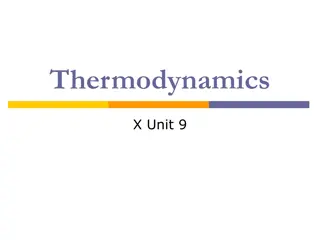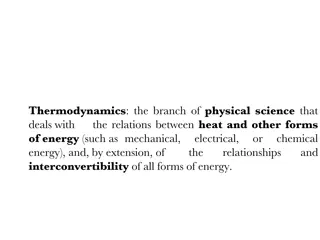Horizon Thermodynamics of Lovelock Black Holes by David Kubiz
Gravitational dynamics and thermodynamics in Lovelock black holes are explored in this talk, discussing free energy, universal thermodynamic behavior, Lovelock gravity, and beyond spherical symmetry. References include works on black hole thermodynamics, local Rindler horizons, and apparent horizons in FRW universes.
Download Presentation

Please find below an Image/Link to download the presentation.
The content on the website is provided AS IS for your information and personal use only. It may not be sold, licensed, or shared on other websites without obtaining consent from the author. Download presentation by click this link. If you encounter any issues during the download, it is possible that the publisher has removed the file from their server.
E N D
Presentation Transcript
Horizon thermodynamics Horizon thermodynamics of Lovelock black black holes holes of Lovelock David Kubiz k (Perimeter Institute) Pressure of all matter fields vs. Black Holes' New Horizons Casa Matem tica Oaxaca, BIRS, Oaxaca, Mexico May 15 20, 2016
Plan of the talk I. Gravitational dynamics & thermodynamics II. Horizon thermodynamics III. Some remarks a) Free energy & universal thermodynamic behavior b) Lovelock gravity: triple points, isolated critical point c) Why cohomogeneity one? d) Beyond spherical symmetry IV. Summary Based on: 1) Devin Hansen, DK, Robert Mann, Universality of P-V criticality in Horizon Thermodynamics, ArXiv: 1603.05689. Devin Hansen, DK, Robert Mann, Criticality and Surface Tension in Rotating Horizon Thermodynamics, 1604.06312. 2)
I) Gravitational dynamics and thermodynamics: some references Black hole thermodynamics: How do the completely classical Einstein equations know about QFT? Sakharov (1967): spacetime emerges as a MF approximation of underlying microscopics, similar to how hydrodynamics emerges from molecular physics. Can we understand gravity from thermodynamic viewpoint? R. G. Cai, Connections between gravitational dynamics and thermodynamics, J. Phys. Conf. Ser. 484 (2014) 012003.
1) Local Rindler horizon: Jacobsons argument T. Jacobson, Thermodynamics of space-time: The Einstein equation of state, Phys. Rev. Lett. 75 (1995) 1260, gr-qc/9504004. Are Einstein equations an equation of state? new developments: Maulik s talk 2) Black hole horizon: horizon thermodynamics T. Padmanabhan, Classical and quantum thermodynamics of horizons in spherically symmetric space-times, Class. Quant. Grav. 19 (2002) 5387. D. Kothawala, S. Sarkar, and T. Padmanabhan, Einstein's equations as a thermodynamic identity: The Cases of stationary axisymmetric horizons and evolving spherically symmetric horizons, Phys. Lett. B652 (2007) 338. 3) Apparent horizon in FRW M. Akbar and R.-G. Cai, Thermodynamic Behavior of Friedmann Equations at Apparent Horizon of FRW Universe, Phys. Rev. D75 (2007) 084003, hep-th/0609128.
II) Horizon thermodynamics Consider a spherically symmetric spacetime with an horizon determined from Identify total pressure P with component of energy-momentum tensor evaluated on the horizon Then the radial grav. field equation rewrites as Universal and cohomogeneity-1: Horizon equation of state: Horizon first law:
Black holes in Einstein gravity The radial Einstein equation Horizon is a regular null surface Temperature reads Identify the total pressure as We recover the Horizon Equation of State: with volume
Horizon first law Starting from the horizon equation of state let s identify the entropy as quarter of the area Multiply So we recovered the horizon first law:
Horizon thermodynamics in Einstein gravity Input: The radial Einstein equation where P is identified with Trr component of stress tensor Identification of T, S, and V by other criteria Output: Identification of horizon energyE (Misner-Sharp mass evaluated on the horizon) Universal (matter independent) horizon equations that depend only on the gravitational theory considered End of story!
III) Some remarks a) Free energy & Universal thermodynamic behavior Define the Gibbs free energy (Legendre transform of E) Can plot it parametrically using the equation of state
Only 3 qualitative different cases (considering all possible matter fields - values of P) P<0: RN case P=0: AF case P>0: AdS case (possibly with Q) H-P transition interpretation?
Universal Q=0 vs. charged Different ensembles (can. vs. grand can.) Effectively reduces to vacuum diagrams Different black holes & environments Universal but the concrete physical interpretation depends on the matter content
b) Generalization to Lovelock gravity Lovelock higher curvature gravity Input: Impose spherically symmetric ansatz Write the radial Lovelock equation where P is identified with Trr component of stress tensor Identify the temperature T via Euclidean trick Identify the true entropy S (Wald) Specify the black hole volume
Output: Identification of horizon energyE (Misner-Sharp energy evaluated on the horizon, an energy to warp the spacetime and embed the black hole horizon) Universal (matter independent) horizon equations that depend only on the gravitational theory considered
Isolated critical point (3rd order and higher) Special tuned Lovelock couplings Odd-order J hyperbolic horizons (k=-1) B. Dolan, A. Kostouki, DK, R. Mann, arXiv:1407.4783.
Critical exponents: Comments: cf. mean field theory critical exponents satisfies Widom relation and Rushbrooke inequality Prigogine-Defay ratio indicates more than one order parameter?
c) Why cohomogeneity one? Consider first vacuum Schwarzschild solution Next take a general solution with general f(r) and g(r) Radial EE + actual Hawking temperature rewrites as horizon equation of state Horizon first law = above (vacuum) first law in terms of true Hawking temperature and Tm.
d) Beyond spherical symmetry Ansatz Identify (cohomogeneity two)
Rewrite the radial Einstein equation as where we identified horizon energy and angular momentum (of vacuum BH) surface tension
Rotating horizon thermodynamics Horizon equation of state: Horizon first law: Cohomogeneity two relation Universal regarding the matter content but ansatz has limited applications Provided a volume V of black hole is freely specified (not- unique) in canonical ensemble (J=const) we can rewrite these as cohomogeneity one Horizon equation of state: Horizon first law:
IV) Summary 1) We reviewed the proposal of horizon thermodynamics showing the equivalence of thermodynamic first law and radial Einstein equation and extended it to rotating black hole spacetimes. 2) The horizon first law is cohomogeneity one (two in the rotating case) 3) Essentially an equivalence class of vacuum first laws (written from a perspective of an observer who measures true temperature)
4) This implies universal thermodynamic behaviour (independent of matter content) that depends only on the gravitational theory in consideration. 5) Interesting phase transitions are observed in Lovelock case (isolated critical point, triple points,..). 6) Compared to the extended phase space thermodynamics of AdS black holes adjusting P more natural? 7) What about a more general rotating ansatz? What is the physical meaning of surface tension sigma?



